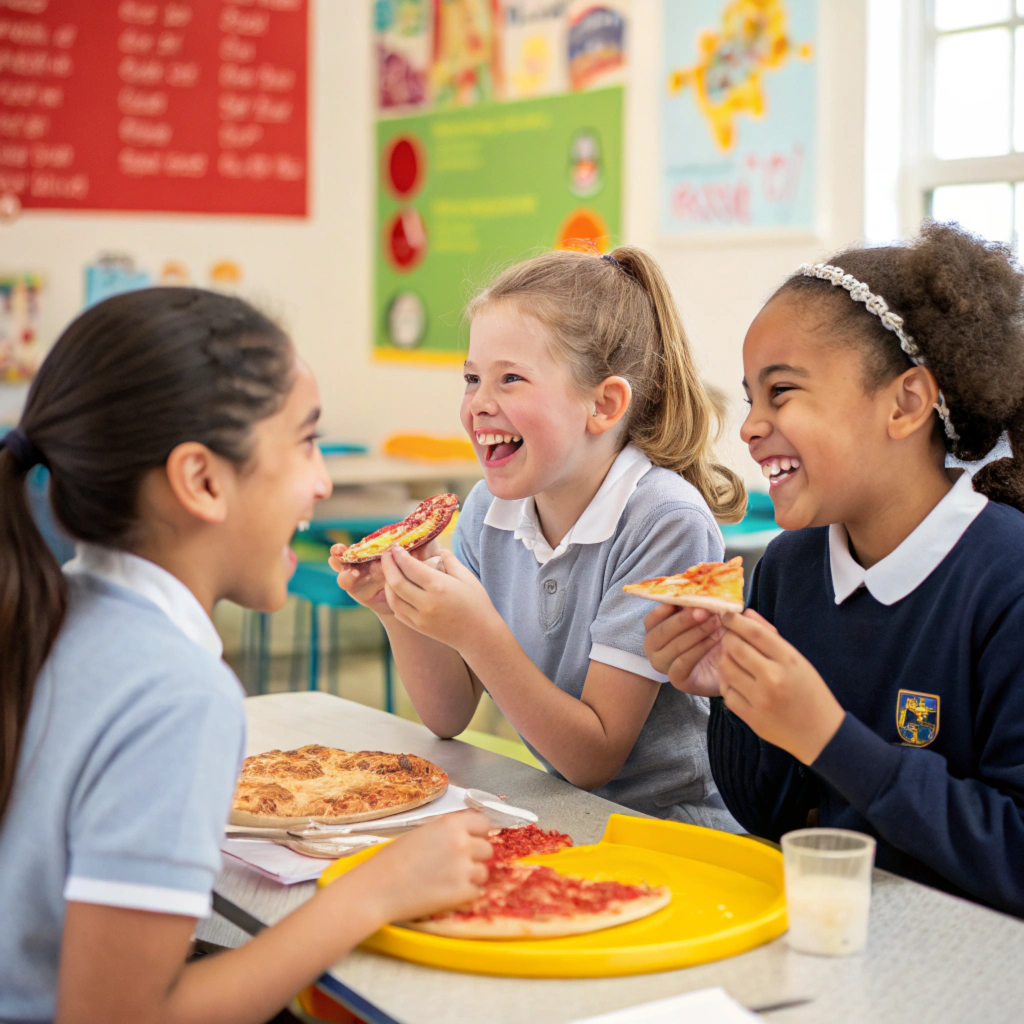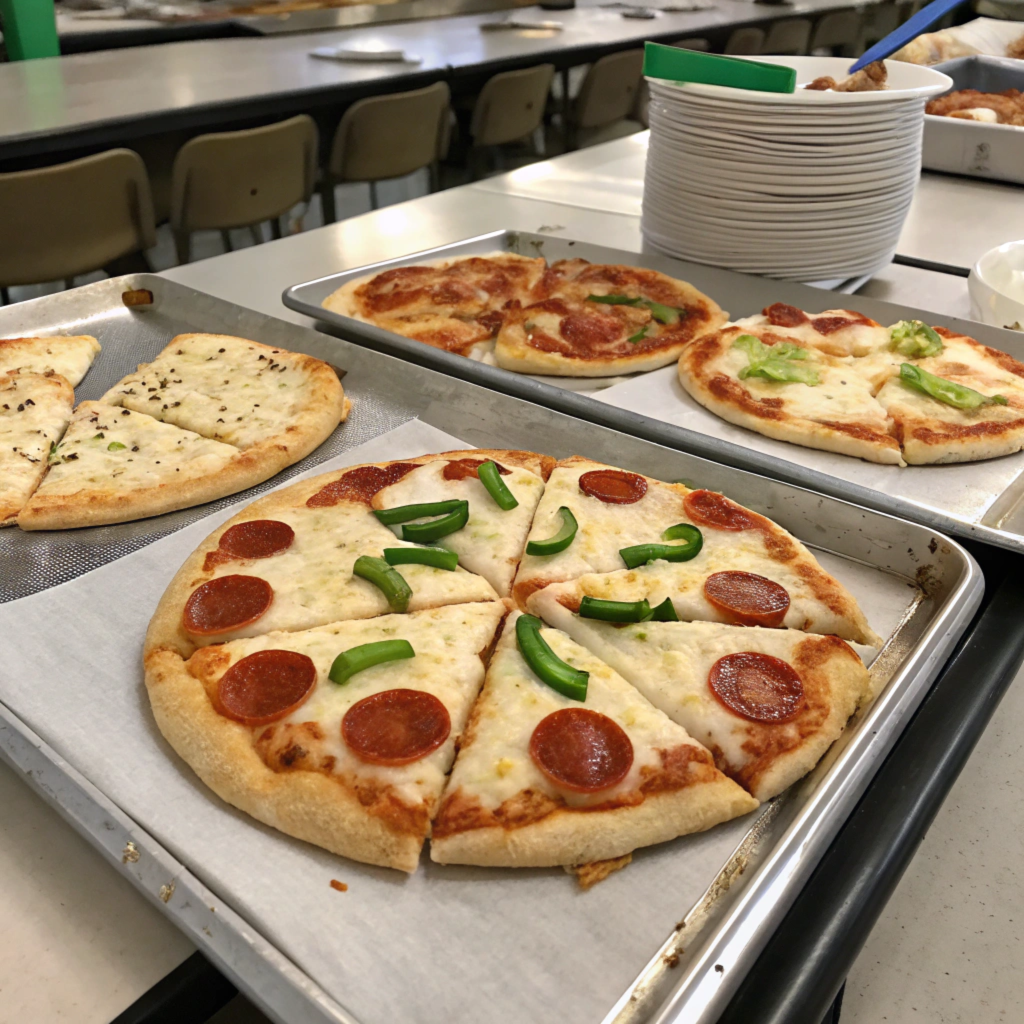
What Are School Pizza Brands?
School pizza brands refer to the iconic companies that supplied pizzas to school cafeterias across the United States. These brands, like Tony’s and Big Daddy’s, became a staple in school meal programs, offering affordable, easy-to-prepare options that met nutritional standards while still appealing to students. Their rectangular slices, mild sauce, and gooey cheese evoke a sense of nostalgia for generations who grew up enjoying them.
Why Were School Pizza Brands So Popular?
Convenience and Cost-Effectiveness
School pizza brands provided pre-made or partially assembled pizzas that were easy for cafeteria staff to prepare in bulk. These pizzas were also budget-friendly, making them a practical choice for school districts.
Taste That Everyone Loved
Despite being simple, the flavors of school pizza brands were a hit with students. The soft crust, lightly seasoned tomato sauce, and melty cheese created a meal that appealed to kids across different age groups.
Meeting Nutritional Guidelines
Over time, school pizza brands adapted their recipes to comply with USDA guidelines for school lunches. By incorporating whole-grain crusts, low-fat cheese, and reduced-sodium options, they ensured that their products fit within healthy meal plans without losing their appeal.
Popular Pizza Brands Used in Schools
Tony’s Pizza: A Cafeteria Classic
One of the most iconic school pizza brands, Tony’s Pizza has been a staple in school cafeterias for decades. Known for its rectangular slices and simple, satisfying toppings, Tony’s became synonymous with school lunch.
History of Tony’s Pizza in Schools
Tony’s Pizza gained popularity in the 1970s when school lunch programs sought affordable, pre-made meals that could be easily prepared in bulk. The brand’s reliable quality and kid-friendly flavors made it a go-to choice for school districts nationwide.
Why Tony’s Pizza Stood Out
- Convenience: Pre-assembled pizzas were easy to bake and serve.
- Cost-Effective: Tony’s offered budget-friendly solutions for schools with tight meal budgets.
- Taste: With its chewy crust, mild tomato sauce, and generous layer of cheese, Tony’s Pizza became a favorite among students.
Big Daddy’s Pizza by Schwan’s Food Service
Big Daddy’s Pizza, a product of Schwan’s Food Service, is another beloved name in school lunch programs. Its thicker crust and bold flavors made it particularly popular in high schools.
Customizing Big Daddy’s for Schools
Schwan’s developed Big Daddy’s Pizza specifically for schools, tailoring the recipes to meet USDA guidelines while retaining its appeal to students. Cafeterias could choose from a variety of options, including cheese, pepperoni, and veggie-topped pizzas.
Features That Made Big Daddy’s Stand Out
- Thick Crust: Filling and satisfying, the crust was a standout feature.
- Generous Toppings: Big Daddy’s pizzas were known for their robust cheese and flavorful toppings.
- Flexibility: Schools could customize the pizzas or serve them as-is, offering flexibility for different student preferences.
Other Notable School Pizza Brands
Red Baron Pizza
This brand provided personal-sized pizzas, making it an excellent option for schools aiming to serve portion-controlled meals. Red Baron’s rich flavors and crispy crusts added variety to school menus.
Smart Pizza
A newer player, Smart Pizza focuses on healthier options, offering gluten-free crusts, reduced sodium, and plant-based toppings to cater to dietary restrictions.
Regional Brands
In addition to national names, many schools partnered with local bakeries and suppliers to create regional variations. These partnerships allowed for fresh ingredients and flavors that reflected the local community’s preferences.
How Were School Pizzas Made?

Ingredients and Preparation
School pizza brands focused on simplicity and efficiency to create affordable yet tasty meals for students. The production process emphasized bulk preparation and compliance with nutritional standards.
Ingredients Used by School Pizza Brands
- Crust: Whole-grain crusts became standard over time to meet USDA guidelines for fiber content. The crusts were pre-made to ensure uniformity and ease of preparation.
- Sauce: A mildly seasoned tomato-based sauce kept flavors kid-friendly while reducing sodium.
- Cheese: Low-fat mozzarella or cheese blends provided the signature gooey texture without exceeding fat limits.
- Toppings: Limited to popular choices like diced pepperoni, sausage crumbles, or plain cheese for simplicity.
Balancing Flavor and Nutrition
- School pizza brands adapted their recipes to combine nutritional value with taste. For example, many brands reduced salt levels in their sauces while adding herbs to enhance flavor.
- Vegetables like diced bell peppers or spinach were sometimes included to provide additional vitamins and meet produce requirements.
Cooking Methods in Cafeterias
Oven-Baked Pizzas for Consistency
Cafeterias typically used industrial convection ovens to bake pizzas evenly and efficiently. These ovens allowed staff to prepare large batches without compromising texture or quality.
Prepackaged vs. Freshly Made Options
- Prepackaged Pizzas: Some schools relied on frozen, preassembled pizzas from brands like Tony’s, which only required heating before serving.
- Freshly Made Pizzas: Other cafeterias used branded crusts and sauces to assemble pizzas on-site, offering a fresher taste while maintaining efficiency.
Bulk Preparation Techniques
- Scaling Recipes: Brands designed their products to ensure consistent portion sizes, making it easy for schools to calculate servings per tray.
- Storage: Frozen pizzas and pre-prepared crusts could be stored for extended periods, reducing waste and simplifying inventory management.
Why Were School Pizzas So Distinct?
The unique taste of school pizzas came from their utilitarian approach to production. The balance of chewy crust, gooey cheese, and mild sauce created a flavor that resonated with students nationwide. Despite being made for efficiency, the simplicity of school pizza brands turned them into a lasting favorite.
The Nostalgia of School Pizza
Why Students Loved School Pizza
A Flavor Unique to School Cafeterias
School pizza brands like Tony’s and Big Daddy’s had a distinct flavor that set them apart from restaurant or homemade pizzas. The combination of a chewy, rectangular crust, mildly seasoned tomato sauce, and perfectly melted cheese was simple yet satisfying. Students grew to associate this unique flavor profile with the joy of pizza day, creating lasting memories tied to these meals.
Consistency Across Generations
For decades, school pizzas followed similar recipes and preparation methods. Whether you attended school in the 1980s or the 2000s, chances are you experienced the same rectangular slice with its familiar texture and taste. This consistency across generations has turned school pizza brands into a unifying element of childhood nostalgia.
Pizza Day: A Weekly Highlight
For many students, pizza day was the most anticipated day of the week. It broke the monotony of regular cafeteria meals and brought a sense of excitement to lunchtime.
- Social Bonding: Pizza day often became a time for students to share food, trade slices, and chat with friends over their favorite meal.
- Universal Appeal: Unlike some school meals, pizza appealed to nearly all students, regardless of age or taste preferences.
The Role of Social Media in Reviving School Pizza Nostalgia
Online Communities Reminiscing About Pizza Day
Social media platforms have brought school pizza brands back into the spotlight. Posts and memes about cafeteria pizza frequently go viral, with users sharing fond memories of their favorite slices.
Recreating School Pizza at Home
Many adults, driven by nostalgia, attempt to recreate school pizza recipes. Online tutorials, recipes, and even branded frozen options have emerged to satisfy these cravings. Key features like rectangular crusts and basic toppings ensure these recreations closely mimic the original experience.
Brands Bringing School Pizza to Retail
Tony’s and Big Daddy’s Frozen Options
Recognizing the demand for nostalgic flavors, brands like Tony’s and Schwan’s have introduced school-style pizzas to grocery store shelves. These frozen pizzas allow adults to relive their childhood while introducing the next generation to the iconic taste.
Independent Producers Offering School-Style Pizza
In addition to well-known brands, smaller companies have started marketing pizzas designed to evoke cafeteria memories. These options often highlight the rectangular shape and classic cheese or pepperoni toppings.
Why Nostalgia Fuels the Popularity of School Pizza
The lasting appeal of school pizza brands lies in the universal experience they represent. Nearly everyone who grew up in the United States has fond memories of pizza day, and the simple joy it brought. This shared nostalgia creates a sense of connection across generations, ensuring that the legacy of school pizza brands endures.
Changes in School Pizza Over Time
Adapting to Modern Nutrition Standards
The Impact of USDA Guidelines
As the National School Lunch Program (NSLP) introduced stricter nutritional standards, school pizza brands had to adjust their recipes to comply. These changes aimed to provide healthier meals while maintaining the appeal of pizza for students.
Key adjustments included:
- Whole Grain Crusts: A shift from refined flour to whole grain crusts ensured higher fiber content and compliance with USDA requirements.
- Reduced Sodium: To address concerns about sodium intake, brands modified their sauces, cheeses, and toppings.
- Calorie Limits: Portion sizes were adjusted to meet calorie restrictions for different age groups, ensuring that students received appropriate meal portions.
Balancing Health and Flavor
Challenges with the Healthier Recipes
The changes, while beneficial for health, often altered the familiar taste of school pizzas. Reduced sodium and whole grain crusts impacted flavor and texture, leading to mixed reactions from students.
Student Feedback and Brand Innovations
School pizza brands responded to feedback by incorporating flavor enhancers such as:
- Herbs and Spices: To compensate for reduced salt, oregano, garlic powder, and other seasonings were added to sauces and crusts.
- Cheese Blends: Using richer cheese blends allowed brands to enhance flavor without adding extra fat.
Evolving Topping Choices

Introducing Vegetables for Nutritional Balance
To meet produce requirements, many school pizzas began featuring vegetable toppings like diced bell peppers, spinach, or mushrooms. These additions provided vitamins and minerals while complementing traditional toppings.
Expanding Options with Plant-Based Alternatives
With the growing demand for vegetarian and vegan options, brands like Smart Pizza introduced plant-based cheese and protein alternatives. These changes ensured that students with dietary restrictions could still enjoy pizza day.
The Move Towards Sustainability and Local Sourcing
Using Locally Sourced Ingredients
Some schools partnered with local producers to create pizzas using fresh, regional ingredients. This shift supported local economies while ensuring the quality of toppings like vegetables and cheese.
Minimizing Food Waste
Brands and schools worked together to reduce waste by offering portion-controlled servings and improving packaging methods. Frozen pizzas with longer shelf lives also helped minimize food spoilage.
The Reaction to Healthier School Pizzas
Initial Resistance
When healthier pizzas were first introduced, many students missed the original recipes. The reduced sodium and changes in crust texture led to complaints from some.
Building Acceptance Over Time
As students became accustomed to the new recipes, acceptance grew. Brands worked to improve flavor profiles, and schools introduced pizza as part of themed meals or events to maintain excitement.
The Future of School Pizza
School pizza brands continue to evolve, balancing tradition with modern health trends. By innovating with plant-based options, regional ingredients, and enhanced recipes, these brands ensure that school pizza remains a staple in cafeterias.
Part 6: Current Pizza Brands in School Lunch Programs
How Schools Choose Pizza Suppliers
School districts rely on several factors when selecting pizza brands for their lunch programs. These choices ensure that the pizzas meet nutritional guidelines, stay within budget, and appeal to students’ tastes.
Key Factors in Pizza Supplier Selection
- Compliance with Nutritional Standards: Brands must meet USDA requirements, such as whole-grain crusts, reduced sodium, and low-fat ingredients.
- Affordability: Cost-effectiveness is a priority for schools operating on tight budgets. Bulk purchasing options and competitive pricing make certain brands more appealing.
- Ease of Preparation: Pre-made or partially assembled pizzas save cafeteria staff time and ensure consistency in taste and quality.
- Student Feedback: Schools frequently gather input from students to determine which flavors and toppings are most popular.
Top Brands in School Lunch Programs
Tony’s Pizza
Tony’s Pizza continues to be a leading choice for schools, thanks to its affordability and ability to meet federal guidelines. The brand offers a variety of options, including:
- Whole-Grain Crusts: Ensuring compliance with USDA standards.
- Kid-Friendly Flavors: Cheese, pepperoni, and sausage remain top picks among students.
- Bulk Options: Pre-packaged pizzas for easy preparation and storage.
Big Daddy’s Pizza by Schwan’s Food Service
Big Daddy’s Pizza caters to older students with its thicker crusts and bold flavors. The brand is known for:
- Generous Toppings: Cheese-heavy options and popular meats like pepperoni.
- Customizability: Cafeterias can add vegetables or other ingredients to match local tastes.
- High School Appeal: Larger portions satisfy the appetites of older students.
Smart Pizza
Smart Pizza emphasizes health-conscious ingredients, making it an excellent choice for schools prioritizing modern dietary trends.
- Gluten-Free and Vegan Options: Suitable for students with dietary restrictions.
- Low-Sodium Choices: Aligning with current health guidelines.
- Focus on Sustainability: Packaging and ingredient sourcing are designed to minimize environmental impact.
The Role of Regional Suppliers
In addition to national brands, many schools partner with local suppliers to diversify their pizza offerings.
Supporting Local Businesses
Working with local bakeries or pizzerias allows schools to serve fresher options while supporting community economies.
Customizable Menus
Regional suppliers often provide more flexibility in terms of toppings, crust types, and portion sizes. For example:
- Southwest Schools: May offer pizzas with a Mexican-inspired twist, such as taco-seasoned toppings.
- Northeast Schools: Might include New York-style thin-crust options for local flair.
Balancing Tradition and Modern Trends
School pizza brands strive to maintain their nostalgic appeal while incorporating modern innovations. By blending classic flavors with health-conscious recipes, they ensure that pizza remains a cafeteria staple.